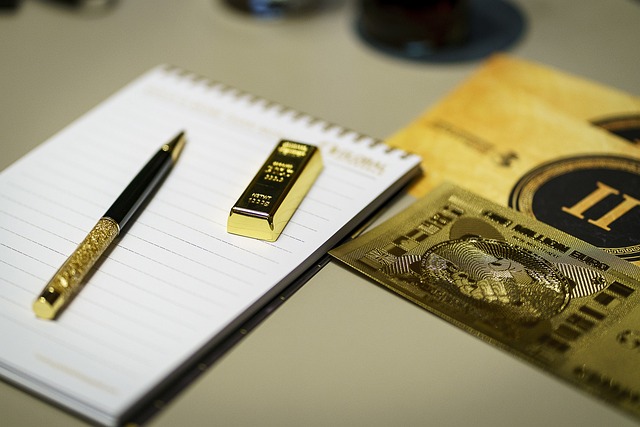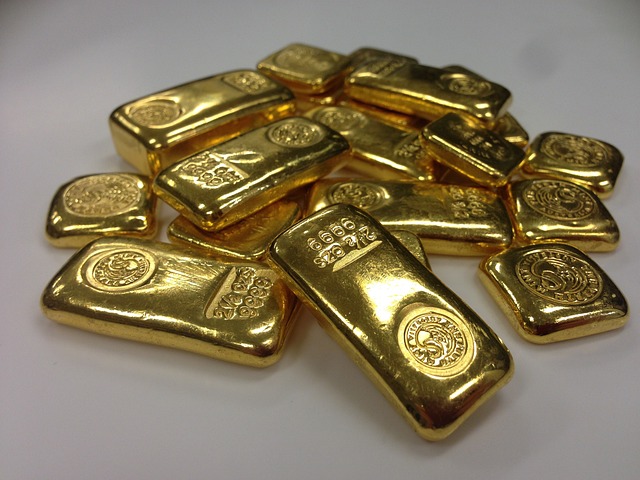To incorporate gold into a retirement portfolio through an IRA, one must establish a self-directed IRA and partner with a custodian specializing in precious metals to ensure compliance with IRS standards. Investments are limited to IRS-approved gold coins, bars, and bullion that meet specific purity requirements. These assets can be purchased through a rollover from an existing IRA, either directly or indirectly, without triggering tax penalties. It's crucial to work with both a knowledgeable custodian and a reputable precious metals dealer who provides regulatory-compliant products and transparent transactions. Self-directed IRAs with gold investments necessitate ongoing adherence to IRS rules, careful monitoring of tax implications, and diversification strategies to safeguard retirement savings against inflation and market volatility. Regular consultation with financial experts, including tax professionals, is advised to navigate the complexities of these investments effectively.
Considering the allure of diversifying retirement savings into tangible assets like gold, this article unveils the pathway to transform traditional IRA funds into physical gold through a self-directed IRA. We’ll explore the nuances of such investments, detail the types of accounts that accommodate precious metals, and outline the precise steps for executing a rollover. From selecting reputable dealers to understanding the compliance and tax implications, this guide ensures you’re well-informed to make prudent decisions in maintaining a self-directed IRA with gold.
- Understanding Self-Directed IRAs for Precious Metals Investment
- Types of Self-Directed IRA Accounts Compatible with Gold
- Steps to Roll Over Traditional IRA into a Self-Directed IRA for Gold Investments
- Selecting a Trustworthy Precious Metals Dealer and IRS-Approved Gold Products
- Maintaining Your Self-Directed IRA with Gold: Compliance, Taxation, and Strategies
Understanding Self-Directed IRAs for Precious Metals Investment

Navigating the transition of a traditional IRA to one that holds gold or other precious metals involves establishing a self-directed IRA. These specialized accounts permit investments in a variety of assets beyond the typical stock and bond holdings, including physical gold, silver, platinum, and palladium coins or bars that meet specific Internal Revenue Service (IRS) standards. To initiate this process, investors must select a custodian experienced in precious metals who is approved by the IRS to handle these types of investments. This custodian will manage the transactions and ensure compliance with all IRS regulations, which are stringent to maintain the tax-advantaged status of the IRA.
The selection of the right precious metals for your self-directed IRA is influenced by purity requirements and market conditions. For instance, the IRS mandates that coins or bars must be certified by an recognized assayer or mint and have a fineness of .995 for gold, .999 for silver, .995 for platinum, and .9995 for palladium. Investors should also consider the historical performance of precious metals as a hedge against inflation and market volatility. It’s crucial to conduct thorough research or consult with financial advisors who specialize in self-directed IRAs and precious metals investment to make informed decisions that align with your long-term financial goals.
Types of Self-Directed IRA Accounts Compatible with Gold

For those looking to diversify their retirement portfolio by including gold, understanding the types of self-directed IRA accounts that are compatible with this precious metal is crucial. Self-directed IRAs come in various forms, each with its own rules and benefits. Traditional and Roth IRAs are the most common types that can be set up to hold gold. Within these accounts, investors can purchase a variety of IRS-approved physical gold products, such as coins, bars, and bullion, provided they meet the purity standards set forth by the IRS.
Another option is the SEP IRA or the SIMPLE IRA, which are employer-sponsored plans that can also include gold among their investments if they are self-directed. These accounts offer higher contribution limits than traditional and Roth IRAs, making them suitable for higher earners or those with substantial employment income. Regardless of the type chosen, it is imperative to work with a trustee or custodian that specializes in precious metals to ensure compliance with IRS regulations. This partnership will facilitate the acquisition, storage, and management of gold within your self-directed IRA framework.
Steps to Roll Over Traditional IRA into a Self-Directed IRA for Gold Investments

To initiate the process of converting a Traditional IRA to a self-directed IRA for gold investments, the first step is to select a custodian that specializes in self-directed IRAs and allows for alternative assets like precious metals. Research and choose a reputable custodian with experience in rare metals and a track record of compliance with IRS regulations. Once you have identified a custodian, establish the self-directed IRA account by providing necessary information and funds to open the account.
Next, you will need to manage a direct or indirect rollover from your existing Traditional IRA to the new self-directed IRA. The IRS outlines specific rules for rolling over funds without triggering taxes or early withdrawal penalties. For a direct rollover, the custodian of your current IRA directly transfers the funds to the new self-directed IRA. An indirect rollover involves withdrawing the funds from your Traditional IRA and depositing them into the new account within 60 days, adhering to IRS limits on the amount that can be rolled over without penalty. After the rollover is complete, you may select the specific gold investments permitted by your self-directed IRA, ensuring they comply with the IRS purity standards for coins and bullion. It’s crucial to coordinate with both the custodian and a precious metals dealer to facilitate this transaction and adhere to all regulatory requirements.
Selecting a Trustworthy Precious Metals Dealer and IRS-Approved Gold Products

When considering the conversion of an IRA to gold, selecting a reputable precious metals dealer is paramount. This dealer must be known for transparency, compliance with regulations, and competitive pricing. The IRS stipulates that for a gold investment to be eligible within an IRA, it must meet purity standards. Investors should look for products like coins or bars that are approved by the IRS, such as those minted by the U.S. Mint, with American Gold Eagles and American Buffalos being popular choices. These products are recognized for their purity and are widely accepted within self-directed IRAs. Additionally, ensure that the dealer provides all necessary documentation to validate the authenticity and IRS acceptance of the gold items. Due diligence in selecting a dealer and the right IRS-approved gold products will lay a solid foundation for a secure and compliant investment strategy within your self-directed IRA.
Maintaining Your Self-Directed IRA with Gold: Compliance, Taxation, and Strategies

When maintaining a self-directed IRA invested in gold, adherence to compliance and understanding of tax implications are paramount. The Internal Revenue Service (IRS) mandates stringent rules for IRA investments, including those in precious metals. To remain compliant, investors must ensure that their gold holdings meet the IRS’s purity standards; generally, gold coins or bullion must be at least 99.5% pure. Additionally, the gold within an IRA must be stored with a custodian approved by the IRS. This custodian will handle the logistics of storing and safeguarding the physical gold, ensuring it is segregated and fully insured.
From a tax perspective, when you acquire gold within your self-directed IRA, the transactions are typically tax-deferred or tax-free if the IRS rules are strictly followed. However, once you withdraw the gold or its equivalent value from the IRA after reaching the age of 59½ or under specific conditions, the proceedings could be subject to income taxes. It’s crucial to consult with a tax professional to navigate these regulations and avoid any inadvertent taxable events. To optimize your self-directed IRA’s performance, consider strategies such as diversifying your gold holdings across different types of precious metals, staying informed on market trends, and regularly reviewing your investment in light of changing economic conditions. This proactive approach will help maintain the value of your retirement savings while adhering to IRS regulations.
In conclusion, transitioning your traditional IRA into a self-directed IRA with gold as an investment can offer a unique diversification strategy within your retirement portfolio. By understanding the nuances of self-directed IRAs for precious metals, selecting the appropriate account type, following the rollover process meticulously, and partnering with reputable dealers for IRS-approved gold products, you are well-equipped to navigate this alternative investment path. It is imperative to stay informed on compliance and taxation matters to maintain your investment’s integrity. With careful planning and adherence to the outlined steps, incorporating gold into your self-directed IRA can be a strategic move for securing your financial future.
